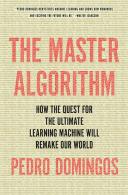Книга: The Master Algorithm: How the Quest for the Ultimate Learning Machine Will Remake Our World
Chapter One
Chapter One
Nine Algorithms That Changed the Future, by John MacCormick (Princeton University Press, 2012), describes some of the most important algorithms in computer science, with a chapter on machine learning. Algorithms,* by Sanjoy Dasgupta, Christos Papadimitriou, and Umesh Vazirani (McGraw-Hill, 2008), is a concise introductory textbook on the subject. The Pattern on the Stone, by Danny Hillis (Basic Books, 1998), explains how computers work. Walter Isaacson recounts the lively history of computer science in The Innovators (Simon & Schuster, 2014).
“Spreadsheet data manipulation using examples,”* by Sumit Gulwani, William Harris, and Rishabh Singh (Communications of the ACM, 2012), is an example of how computers can program themselves by observing users. Competing on Analytics, by Tom Davenport and Jeanne Harris (HBS Press, 2007), is an introduction to the use of predictive analytics in business. In the Plex, by Steven Levy (Simon & Schuster, 2011), describes at a high level how Google’s technology works. Carl Shapiro and Hal Varian explain the network effect in Information Rules (HBS Press, 1999). Chris Anderson does the same for the long-tail phenomenon in The Long Tail (Hyperion, 2006).
The transformation of science by data-intensive computing is surveyed in The Fourth Paradigm, edited by Tony Hey, Stewart Tansley, and Kristin Tolle (Microsoft Research, 2009). “Machine science,” by James Evans and Andrey Rzhetsky (Science, 2010), discusses some of the different ways computers can make scientific discoveries. Scientific Discovery: Computational Explorations of the Creative Processes,* by Pat Langley et al. (MIT Press, 1987), describes a series of approaches to automating the discovery of scientific laws. The SKICAT project is described in “From digitized images to online catalogs,” by Usama Fayyad, George Djorgovski, and Nicholas Weir (AI Magazine, 1996). “Machine learning in drug discovery and development,”* by Niki Wale (Drug Development Research, 2001), gives an overview of just that. Adam, the robot scientist, is described in “The automation of science,” by Ross King et al. (Science, 2009).
Sasha Issenberg’s The Victory Lab (Broadway Books, 2012) dissects the use of data analysis in politics. “How President Obama’s campaign used big data to rally individual votes,” by the same author (MIT Technology Review, 2013), tells the story of its greatest success to date. Nate Silver’s The Signal and the Noise (Penguin Press, 2012) has a chapter on his poll aggregation method.
Robot warfare is the theme of P. W. Singer’s Wired for War (Penguin, 2009). Cyber War, by Richard Clarke and Robert Knake (Ecco, 2012), sounds the alarm on cyberwar. My work on combining machine learning with game theory to defeat adversaries, which started as a class project, is described in “Adversarial classification,”* by Nilesh Dalvi et al. (Proceedings of the Tenth International Conference on Knowledge Discovery and Data Mining, 2004). Predictive Policing, by Walter Perry et al. (Rand, 2013), is a guide to the use of analytics in police work.
- Part One. “Regulability”
- Setting the Time Zone
- All-in-One (Print
- CHAPTER ONE: The Machine-Learning Revolution
- CHAPTER 35 Handling Telephone Calls
- Chapter 5. Preparations
- Chapter 6. Traversing of tables and chains
- Chapter 7. The state machine
- Chapter 8. Saving and restoring large rule-sets
- Chapter 9. How a rule is built
- Chapter 10. Iptables matches
- Chapter 11. Iptables targets and jumps




